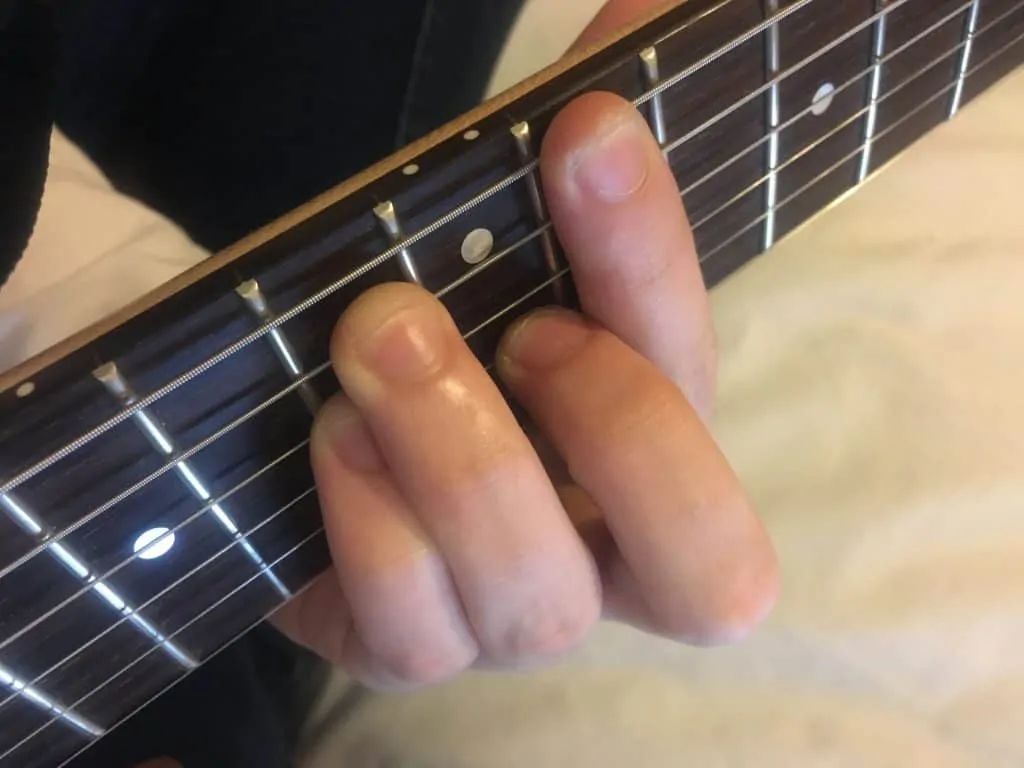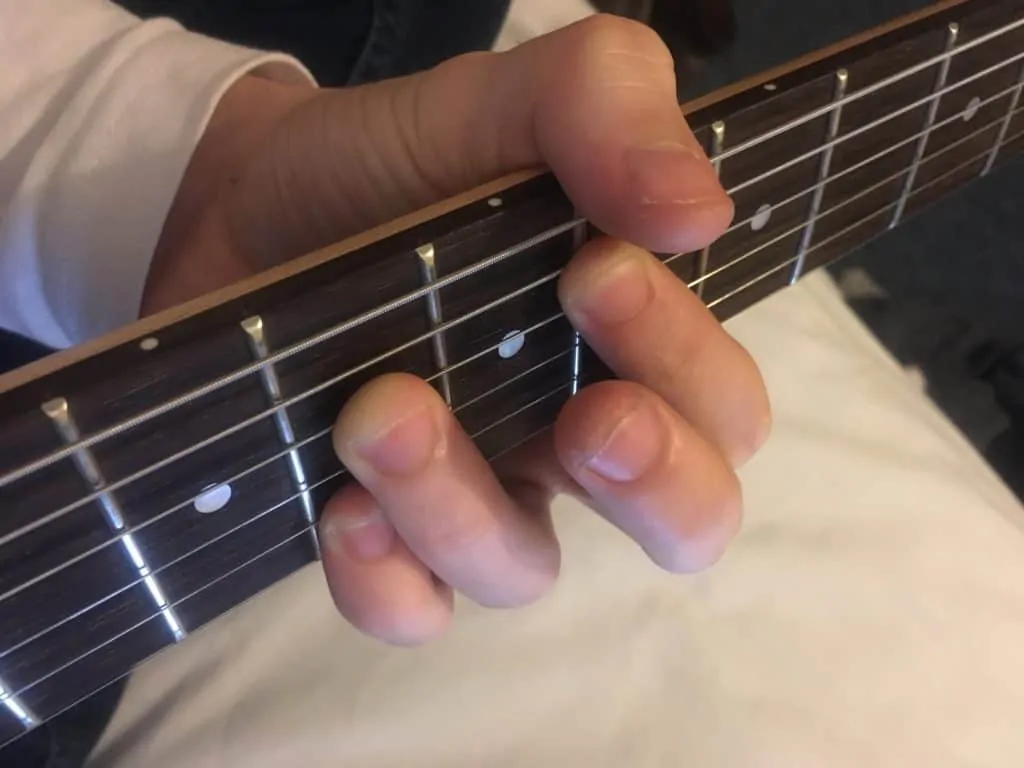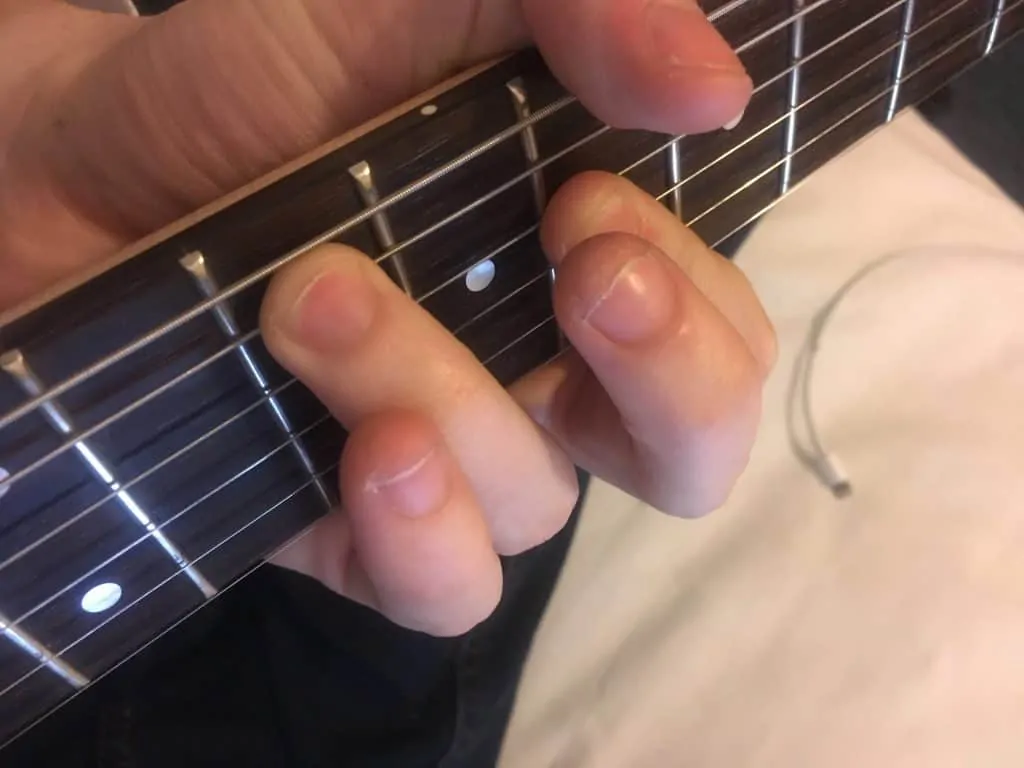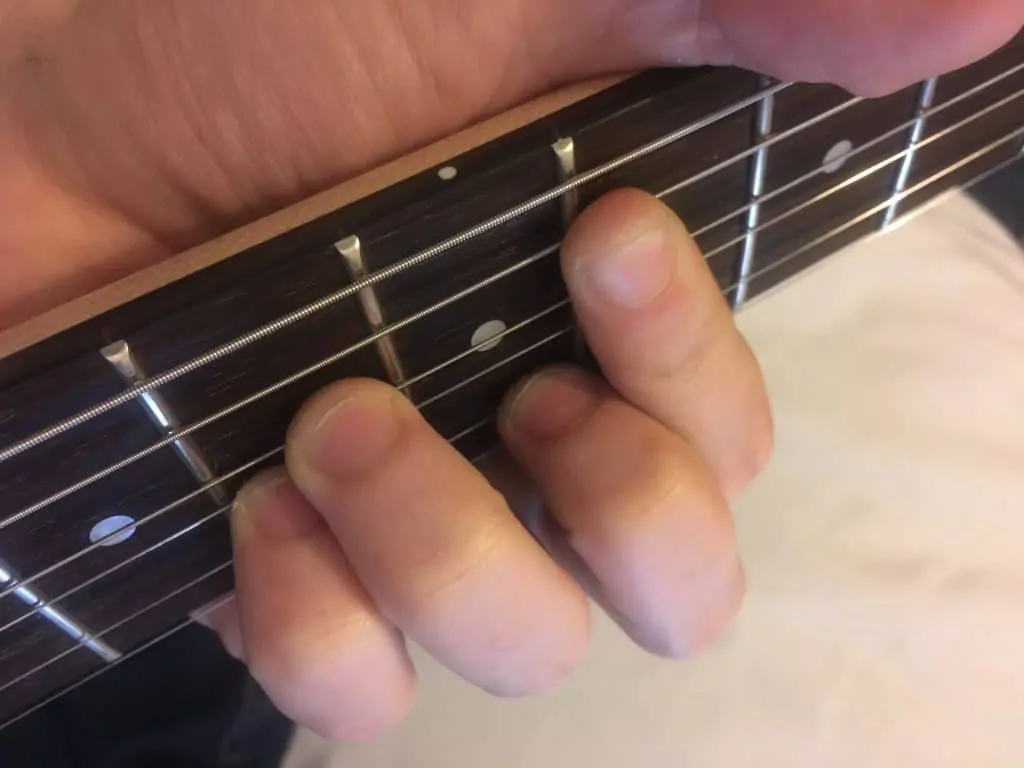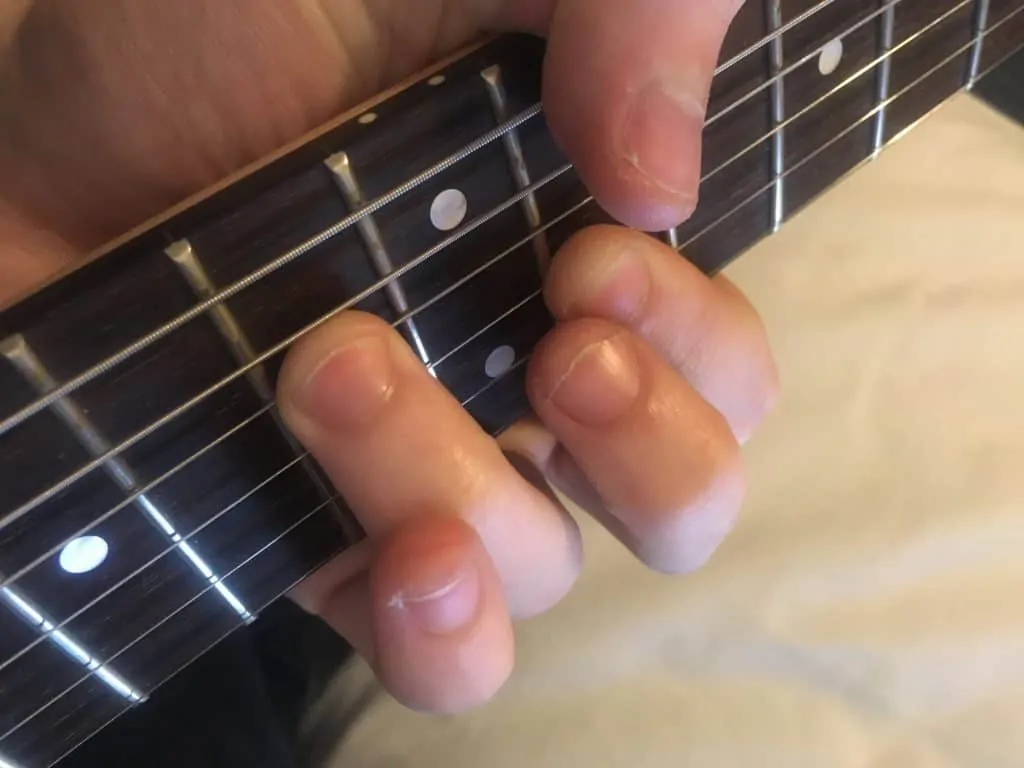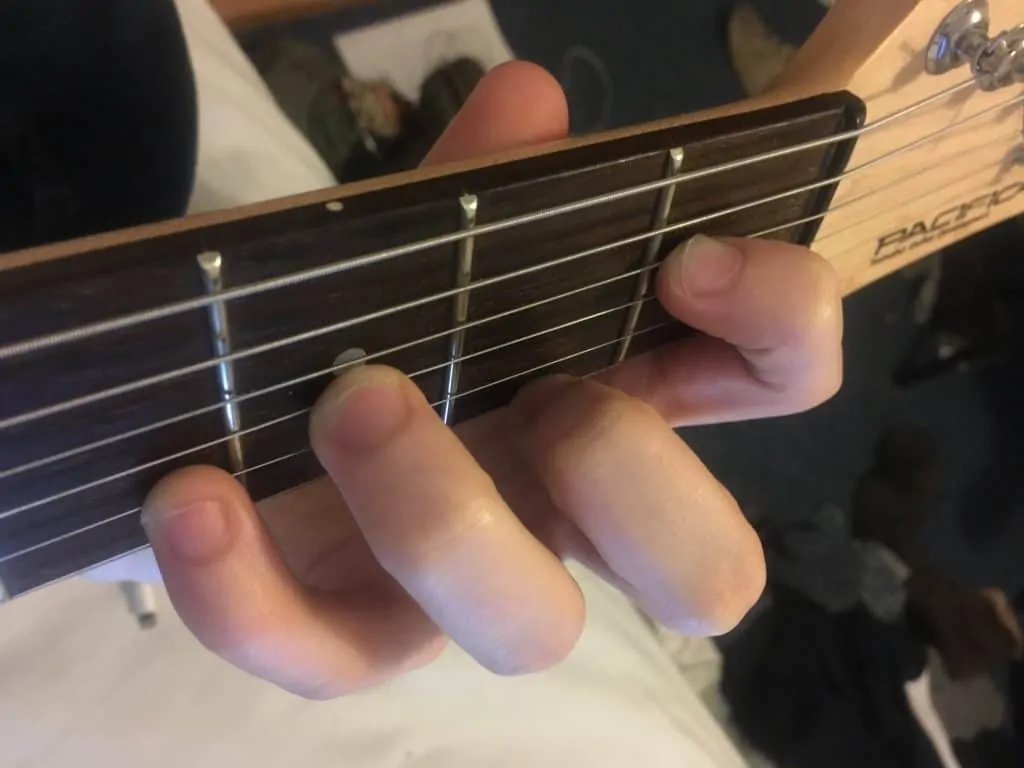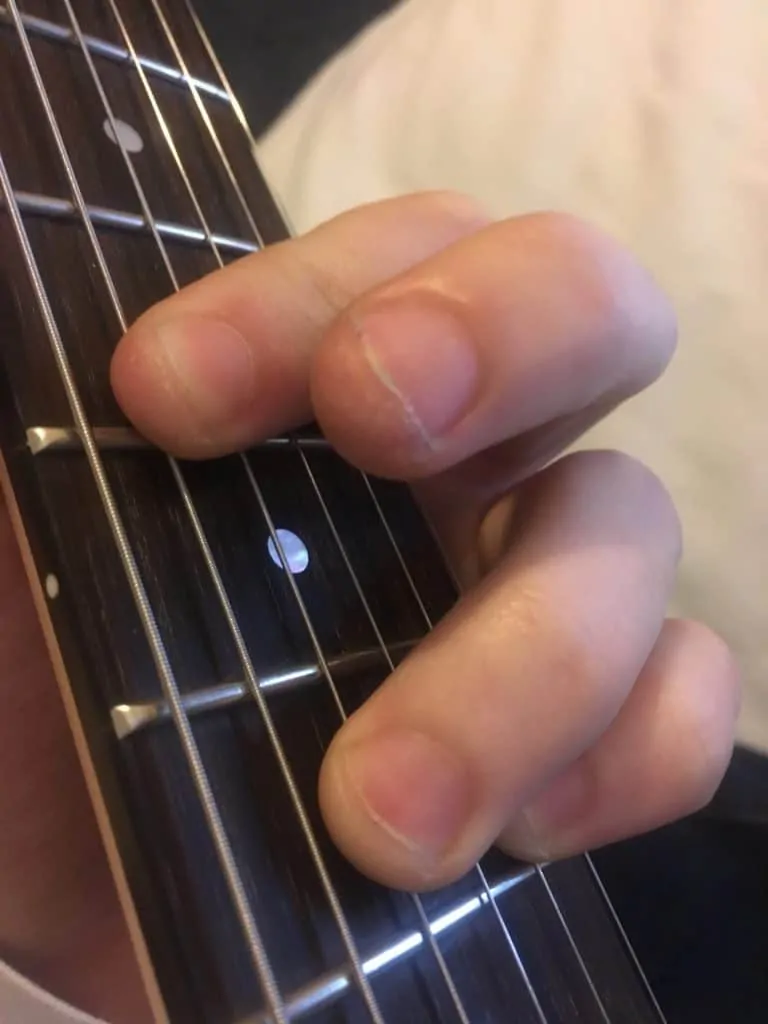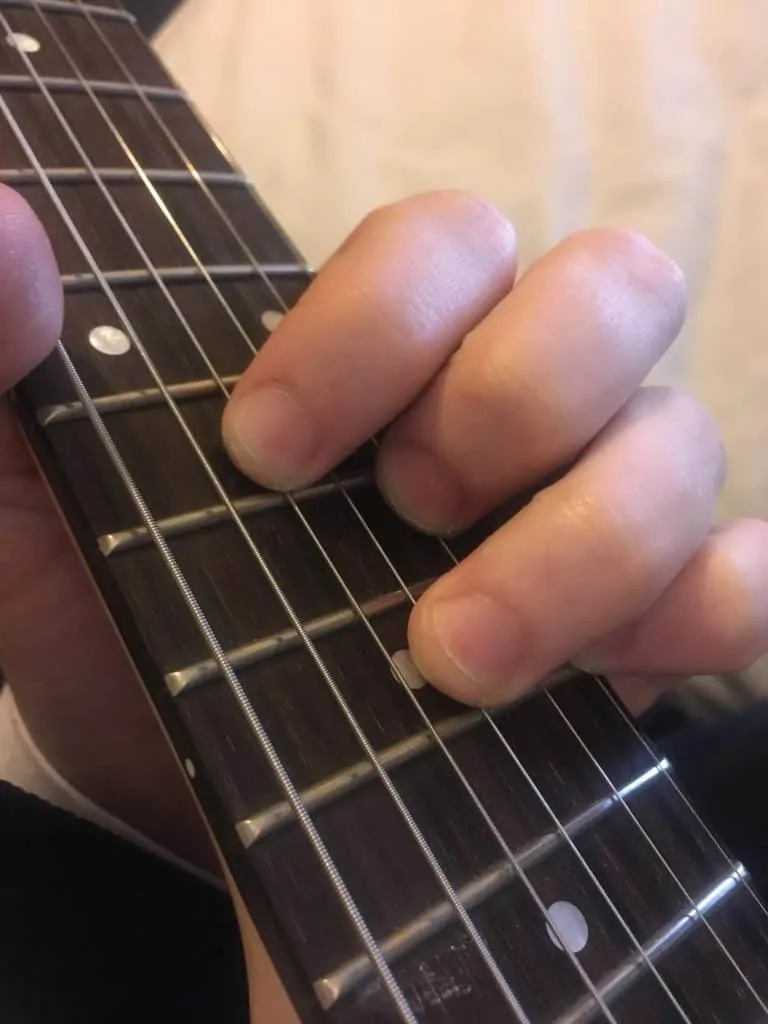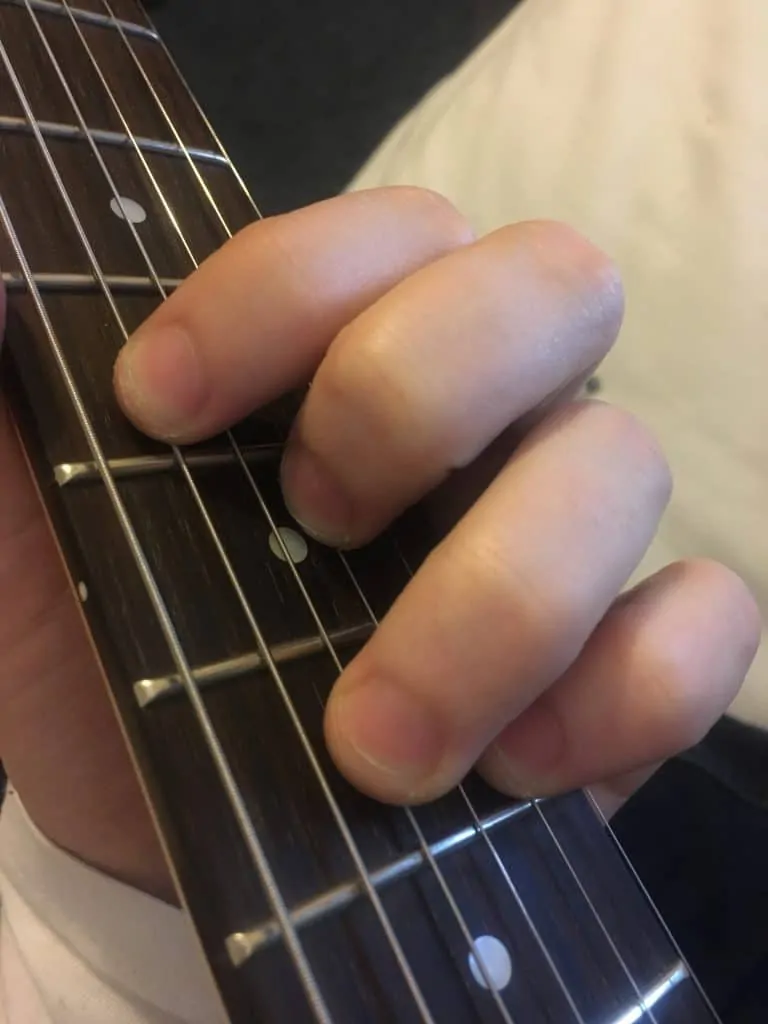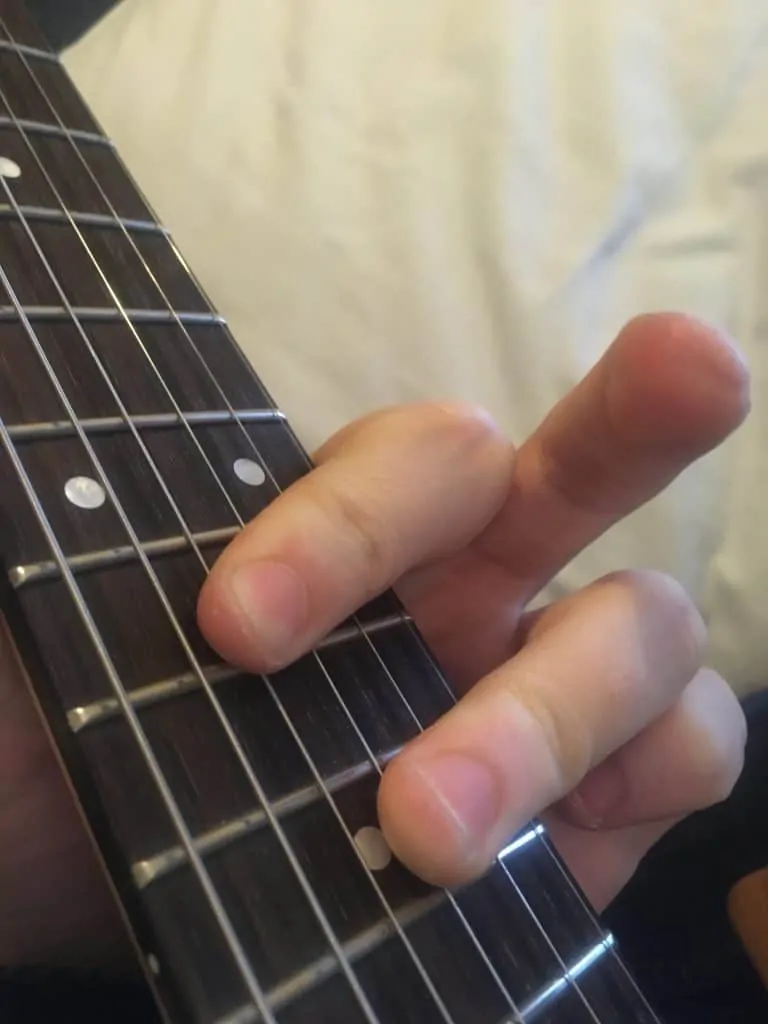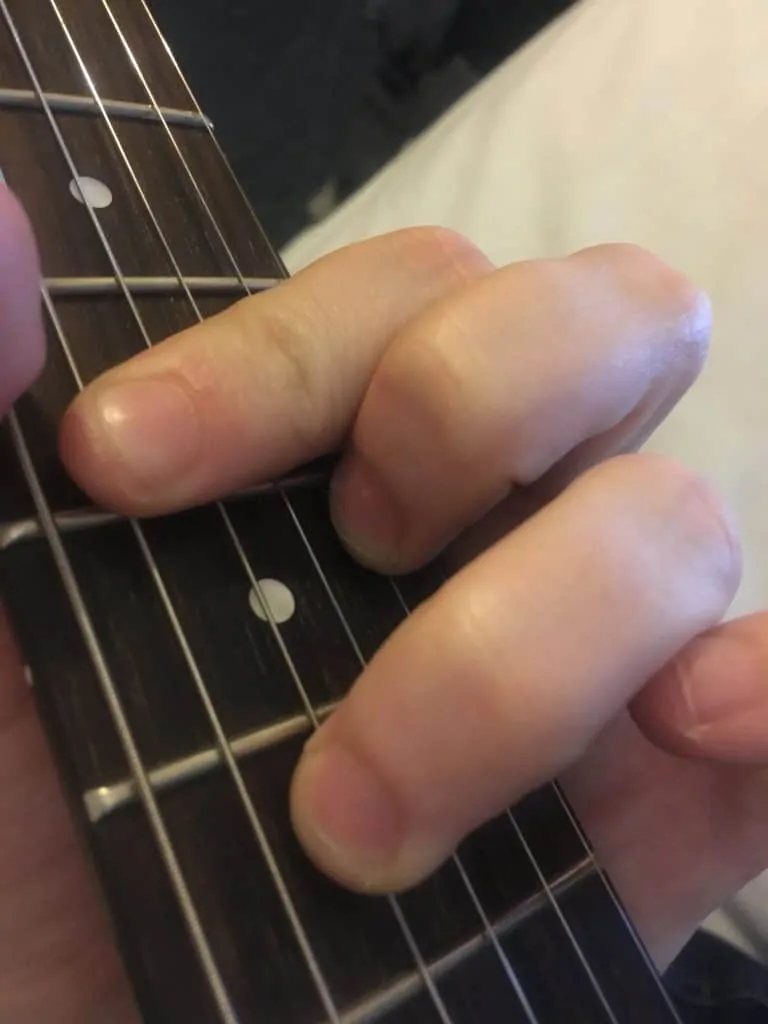Having already looked at ‘open’ chords and their simple shapes, it’s time to move towards some harder to grasp, rarer chords that are known as the ‘black notes’ on a piano.
In this important guide, I’ll be taking you through a huge number of variants of the D#/Eb chord:
If you’re looking for a place to start with D#/Eb chords, then look no further…
Contents
Guitar Chord D Sharp Major
Every major scale has the same theory behind it, building on a pattern of tones between the notes: 1-1-1/2-1-1-1-1/2. On a piano, the ‘1’ means that if you’re starting on the C, then there will be one note (Eb in this case) between your C and the next note of the scale (D), while the 1/2 means that the next note of the scale is directly next door (such as in the move from E-F in C major). On a guitar, the 1/2 means the next fret is in the scale, and the 1 means there will be a fret in between the two notes.
D# major: D#, E#, F##, G#, A#, B#, C##
Eb major: Eb, F, G, Ab, Bb, C, D, Eb
You may have noticed that we’re looking at two scales here. Sort of… Technically a D# and an Eb are exactly the same, they just appear in different contexts. Hence why is you take a look at the scales above, each note is the enharmonic equivalent of each other, so if you played a D# major scale out of context, it would be completely impossible to determine whether it was D# or Eb.
For example, in a key with flattened notes, then you’ll (normally) be playing a Eb if you need to use that note, but in a key with sharps, then it’ll (normally) be a D#. Eb is much more common than D#, so we’ll approach most of the chords below from the Eb perspective.
Each of these notes (degrees of the scale) can be assigned a number as it ascends so you can use a helpful formula to work out chords from it. The D# is a 1, the E# is a 2 etc. while for Eb major, the Eb is a 1, the F is a 2 etc.
Once you’re familiar with the scale, you’ll do well to remember that the formula for a D# major chord (and any tonic major chord of any key) is 1-3-5 which gives the notes D#-F##-A# while the formula for a Eb major chord is 1-3-5 which gives the notes Eb-G-Bb.
Within the key of D#/Eb major, you can make various chord sequences and work them out using this numbering system, but remember that D#/Eb major is your tonic, and is where the key will sound resolved and at home.
Songs That Use D#/Eb Major Chords
There isn’t much point in choosing to play a D#/Eb chord specifically (unless it’s to house a singer’s range etc.) as the actual note isn’t really going to change the sound of the chord, just the pitch. However, the way you play your chord is important and will determine which styles each variation should be used in.
- Imagine Dragons- Demons
- Survivor- Eye Of The Tiger
- Van Halen- Panama
- Kanye West- Power
- Elton John- Your Song
- Toto- I Won’t Hold You Back
- Owl City- Fireflies
- Michael Bublé- Save The Last Dance For Me
- Weezer- Say It Ain’t So
- James Blunt- You’re Beautiful
- Josh Groban- You Raise Me Up
- Britney Spears- Toxic
- Marvin Gaye- Let’s Get It On
Playing E#/Eb Major
Variation 1
When creating a D#/Eb major chord, you’re able to essentially translate the shape of an E major chord up the neck to the 11th fret. If you’re comfortable with barre chords then this one is probably your best option to get a clean, full sound from the chord.
You’ll want to barre the 11th fret using your 2nd finger, then use your 4th to press down on the 13th fret of string 5, your 5th finger to press down on the 13th fret of string 4, and then bring your 2nd finger over to press on the 12th fret of string 3.
Variation 2
This variation of D#/Eb major brings you further down the neck, but essentially creates the same sound as version 1, as most of the notes are technically the same and in the same octave. Choosing between the two is mostly a case of personal preference and ease of chord changing, based on what chords you’d been playing up to now/will be playing afterwards.
Barre the 6th fret with your 2nd finger, but be careful to mute your low E string to avoid having it dissonantly ring out below your chord. Then press your 4th across the 8th fret of strings 3 and 4 and your 5th finger on the 8th fret of the 2nd string.
Variation 3
After two barre chords, we need something a bit more simple. This version of the D#/Eb chord can be used with quite simple movement if you’re playing some open acoustic chords, particularly if you’re moving from a D major chord.
Make sure you mute your three lowest strings, then press your 2nd finger on the 3st fret of the 3rd string, your 4th finger on the 4nd fret of the 2nd string and your 3rd finger on the 3st fret of the 1st string.
Variation 4
While it is a bit too hard to reach far enough up the neck to accurately play a really high, funky chord as we could in the guide to C#/Db, but this type of chord can still give you a good control over staccato and legato playings.
Essentially, make sure your lowest and highest strings are muted and then use your 2nd finger to barre the 8th fret of the 5th and 4th strings and your 3rd finger to press down on the 10th fret of the 5th string.
Guitar Chord D Sharp Minor
A minor scale differs slightly from a major scale in that degrees 3, 6 and 7 are all flattened, so they are lowered by one semitone. This creates the D#/Eb natural minor scale (variants such as the harmonic and melodic minor will be looked at in a separate guide).
D# minor: D#, E, F#, G#, A#, B, C#
Eb minor- Eb, F, Gb, Ab, Bb, Cb, Db
We could apply numbers to these much like we did with the major scale, so a minor chord would still be 1-3-5, like the major. But this is a bit confusing, so let’s approach it from the context of the major scale.
A D# minor chord is 1-b3-5, so therefore made up of the notes D#-F#-A#, while an Eb minor chord is Eb-G-Bb.
These keys are a lot more accessible than the D# major scale, so both are relatively equal in their rarity.
Songs That Use D#/Eb Minor
Again, rarely does a song seek to use the D#/Eb note specifically, but rather the minor chord itself. Whether it is as part of the key and therefore makes sense, or to bring out its sadder sound than a major chord, a minor chord is something important throughout all music.
- Metallica- I Disappear
- Limp Bizkit- Take A Look Around
- Stevie Wonder- Superstition
- The 1975- Girls
- Ed Sheeran- Bloodstream
- Guns N Roses- Civil War
- Placebo- English Summer Rain
- Gabrielle Aplin- Heavy Heart
- Metallica- Fuel
- Adele- River Lea
Playing D#/Eb Minor
Variation 1
High up the neck, you can create another E-based shape in order to pull off a D#m/Ebm chord, this time it is the minor version you’ll be recreating with a barre underneath.
Barre the 11th fret with your 2nd finger, then press your 4th finger onto the 13th fret of the 5th string and your 5th finger onto the 13th fret of the 4th string. Make sure your barre is pressing the 11th fret of string 3 hard enough for it to be heard.
Variation 2
Now we can use our classic, simple minor chord shape, in this case with the lowest C# root note available to you opening the chord. Personally, this type of minor shape is always my favourite as it can lends itself to so many different styles of playing.
Use your 2nd finger to barre the 6th fret, but make sure to mute the low E string again (though technically this could fit the chord if you’d prefer an E root). Then use your 4th finger to press down the 8th fret of the 4th string, your 5th finger to press the 8th fret of string 3 and your 3rd finger to press down the 7th fret of the 2nd string.
Variation 3
This one gives you a nice variation pretty high up the neck, and in this variation, you can use the partial barre to bounce up and down on the string and give good control after your level of staccato.
Barre the 11th fret of the 1st, 2nd and 3rd string, while moving your 4th finger over the press down the 13th fret of string 4. Make sure you keep muting the lowest two strings.
Variation 4
While a lot of these chord variations are pretty simple, they don’t give a particularly broad spread across the octave. With this harder to reach, but more detailed chord you can get a nice spread of notes.
Press your 2nd finger onto the 1st fret of the 4th string, your 4th finger on the 3rd fret of the 3rd string, your 5th finger on the 4th fret of the 2nd string, and your 3rd finger on the 2nd fret of the 1st string.
Guitar Chord D Sharp 7
A D#7/Eb7 chord, or D#/Eb dominant 7, is a major chord with an added minor 7th. This creates an interval of a tritone within the chord, adding a laying of dissonance to the sound. In a lot of music, the D#/Eb7 is used as part of a perfect cadence, in order to resolve to the tonic. However, one of the primary uses of the dominant 7th in modern music, is as a part of jazzy chord sequences.
If we use major scale theory (which we would unless you’re delving into the realm of modality where this chord has a strong Mixolydian quality) then the formula for this chord is 1-3-5-b7. The b7 takes the C## of a D# major scale down to a regular C#, or the D of ab Eb major scale down to a Db.
This means that the notes in a D#7 chord are D#-F##-A#-C#, while the Eb7 chord is made up of the notes Eb-G-Bb-Db.
Songs That Use C#/Db7
D#7 chords are almost unused in popular in guitar music, but Eb is a really common chord to come across. The use of the dominant 7th gives a distinctive dissonance that allows the chord to be use in poignant parts of slower songs, while fit into jazzy, faster numbers.
- Catie Turner- Pity
- Superfood- Moodbomb
- Kate Bush- Houdini
- Cliff Richard- Dream
- Ella Eyre- Good Luck
- Eva Cassidy- At Last
- Coldplay- Twisted Logic
- David Bowie- Lets Dance
Playing D#/Eb7
Variation 1
One of the easiest ways to play a D#/Eb7 chord is in the most standard dominant 7th chord shape. This is centred on the 5th string root note and is another good mid-range chord that can be found in loads of styles.
Simply barre the 6th fret using your 2nd finger, muting the low E string, then press your 4th finger down on the 8th fret of string 4, then press your 5th finger down onto the 8th fret of the 2nd string. Make sure you press the 6th fret of the 3rd string down hard enough to hear it as it creates the chord’s most important interval.
Variation 2
This shape is really easy to form and then move up and down the neck in order to provide dominant 7th chords wherever you want. This one lends itself nicely to jazzy playings.
Press down on the 4th fret of the 2nd string using your 2nd finger, then bring your 3rd finger over to the 5th fret of the 4th string, then use your 4th finger to press down on the 6th fret of the 5th string and your 5th finger on the 6th fret of the 3rd string.
Variation 3
Lending itself to funk by residing so far up the neck, this shape is a little rarer and a little harder than the ones we’ve approached previously, but it is good for allowing each note to be clearly heard.
Press your 2nd finger onto the 13th fret of the 4th string, then press your 4th finger onto the 15th fret of the 3rd string, your 3rd finger on the 14th fret of the 2nd string and your 5th finger on the 15th fret of the 1st string.
Guitar Chord D Sharp Major 7
A D#/Ebmaj7 chord is simply a major chord with a major 7th attached to the top. This often gives it a very uplifting sound, but there is an underlying dissonance due to the major 7th interval.
If we look at it from the point of view of the major scale algorithm, then the chord outlines a pattern of 1-3-5-7.
This means that the notes in an D#maj7 chord are D#-F##-A#-C##, while an Ebmaj7 chord is made up of Eb-G-Bb-D.
Songs That Use D#/Ebmaj7
D#maj7 is a good one when used in many contexts due to its ability to slot well into jazz and pop styles. Soul music also finds itself with a lot of maj7 chords chucked in throughout.
- Amy Winehouse- Valerie
- Rex Orange County- Loving Is Easy
- Ella Fitzgerald- Misty
- Ylvis- Stonehenge
- Lukas Graham- 7 Years
- Coldplay- High Speed
- The Police- Roxanne
- The Script- Breakeven
- Editors- Munich
- Mac Miller- Hurt Feelings
- John Legend- Ordinary People
Playing D#/Ebmaj7
Variation 1
One of the easiest and most common maj7 shapes you can encounter is probably one you’re probably familiar with thanks to our other guides such as the A chord.
Use your 2nd finger to barre the 6th fret, before pressing your 4th finger onto the 8th fret of the 4th string, your 3rd finger onto the 7th fret of the 3rd string and your 5th finger onto the 8th fret of the 2nd string.
Variation 2
Yet again, we can use a nice high on the neck variation when playing funky chords. However, remember their usage isn’t limited just to this; for example you could fill your guitar with tremolo and be given a nice, wobbling sound when playing chords high on the neck like this.
Place your 2nd finger on the 13th fret of the 4th string, and then use your 4th finger to barre the 15th fret from string 1-3. Make sure you’re able to mute the two lowest strings to avoid having them ring out.
Variation 3
If your grasp of music theory is good, you may have noticed that a Ebmaj7 chord is basically a Gm chord with an Eb root note added. This variation basically takes a simple Gm shape and adds this Eb root to the low end.
Barre the 4rd fret of strings 1, 2 and 3 then reach your 4th finger over to the 6th fret of the 4th string, and your 5th finger over to the 7th fret of the 5th string. Mute the low E again.
Guitar Chord D Sharp Minor 7
The D#/Ebm7 chord (D# minor 7) is based on a minor chord with a minor 7th above. It’s sort of the sadder version of the major 7th chord, giving off more of a negative sound due to the minor 3rd, but less dissonance due to the minor 7th interval instead of the major 7th.
If we look at it using the major scale formula, then it follows a pattern of 1-b3-5-b7.
This means that the notes in a D#m7 chord are D#-F#-A#-C#, while Ebm7 is made up of the notes Eb-Gb-Bb-Db.
Songs That Use D#/Ebm7
Similarly to D#maj7/Ebmaj7, D#m7/Ebm7 can fit nicely into a lot of jazz music due its 7th interval, but equally it appears a lot in popular music styles as despite its dissonance, it has a pleasant tone.
- Jamiroquai- Virtual Insanity
- Modjo- Lady
- America- And Forever
- Sade- King Of Sorrow
- Kanye West- Bound
- Stevie Wonder- I Wish
- Nina Simone- Feeling Good
Playing D#/Ebm7
Variation 1
Like with the D#maj7 above, there is a distinctly simple variation of this chord type that you can move up and down the neck with ease, and that lends itself to a variety of styles.
Barre the 6th fret using your 2nd finger, then use your 4th finger to press the 8th fret of the 4th string, and your 3rd finger to press down on the 7th fret of the 2nd string. In this case, you’re going to want to mute both the high and low E strings.
Variation 2
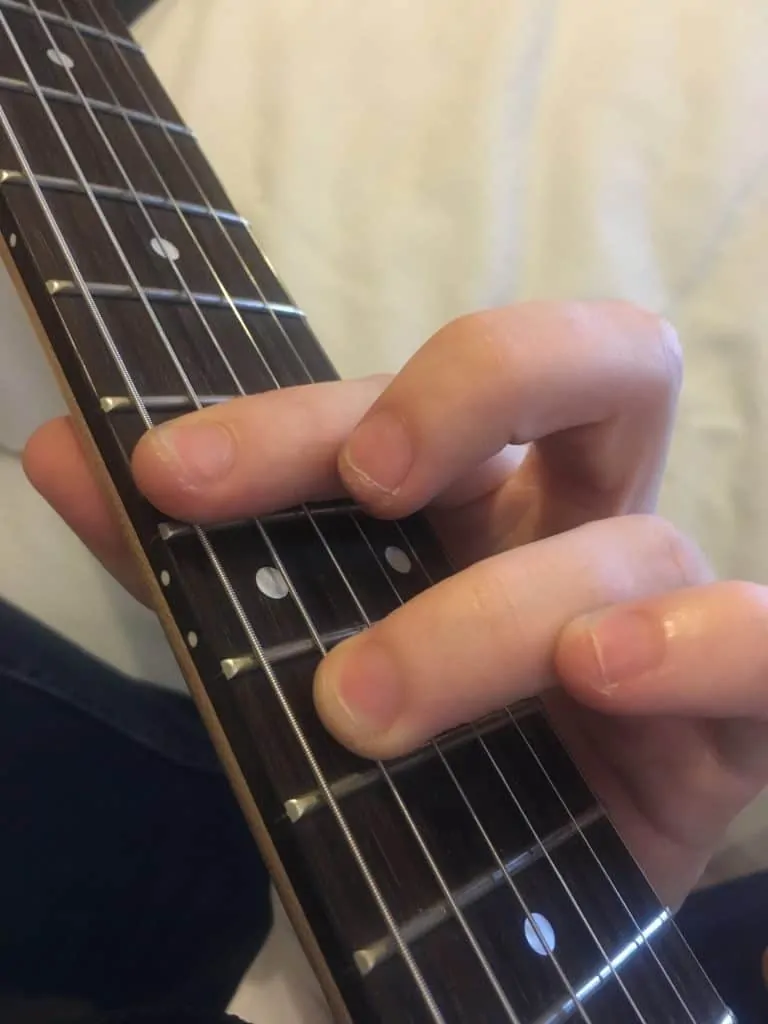
This barre version is arguably the easiest way of playing a D#m7, but due to its centrality on the lowest string, I feel it sounds a bit blurred; but if you’re just getting used to barre chords then it is a good one to get started with.
Barre the entire 11th fret using your 2nd finger, then press down on the 13th fret of the 5th string using your 4th finger. Simple as that!
Variation 3
A nice way of creating an Ebm7 is through another bridge chord in which you can create a shape that runs parallel across the same fret, though you going to need to bunch all your fingers quite tightly together.
Use your 2nd finger to press down on the 11th fret of the 6th string, then skip over the 5th string (make sure it is muted) and then press your 3rd, 4th and 5th fingers on the 11th fret of the 4th, 3rd and 2nd frets respectively.
Other C#/Db Chords
There are a lot of other types of chords you can use based around your C#/Db tonic. The ones I’ve shown you so far are probably the most common you’ll come across, particularly major and minor.
- Ebmaj9 adds an extra 9th to the top of a maj7 chord; this creates a really nice sound using the notes Eb-G-Bb-D-F.
- Ebm7sus6 adds a 6th into the chord, which typically suspends the 5th onto a 6th instead. Often, this suspension will be resolved soon after. It’s made up of: Eb-Gb-Cb-Db
- D# no 3rd is an interesting, ambiguous chord as it drops the note that signifies whether the chord is major or minor. Technically, a standard power chord is a no 3rd chord because the notes are simply D#-A#.
There are obviously a lot more chords than this, but these are a few I really like. I have a few tricks to bear in mind when working out chords yourself.
- If you’re in an alternate tuning, remember these explanations won’t be the same!
- Using a formula to work out what notes are in a chord is a really simple way to help you out.
- When building chords that are hard to voice, the 5th is the first degree of the chord you are able to drop. Never drop the root, because that will normally completely change the chord you’re playing. For example, dropping the Eb from an Ebm7 chord just makes Gb major…
Good Luck!
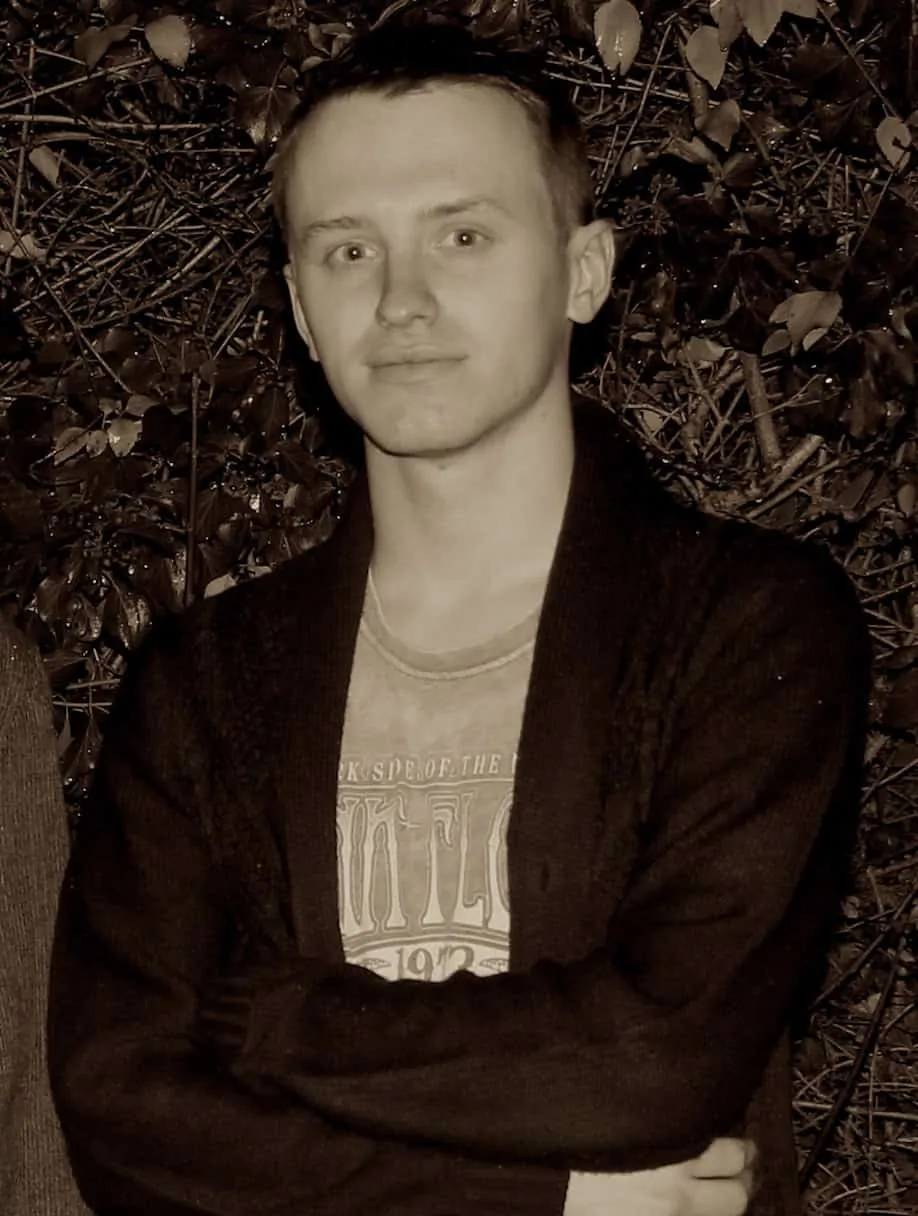
Dan is a music tutor and writer. He has played piano since he was 4, and guitar and drum kit since he was 11.
He plays a Guild acoustic and a Pacifica electric. He has been sent to many festivals and gigs (ranging from pop to extreme metal) as both a photographer and reviewer, with his proudest achievement so far being an interview he has with Steve Hackett (ex-Genesis guitarist).
He ranks among his favourite ever guitarists, alongside Guthrie Govan, Jimmy Page, Jimi Hendrix, David Gilmour and Robert Fripp. His favourite genre of music is progressive rock, which he likes to use as a reference point in my teaching, thanks to its huge complexity in structure, rhythm and harmony. However, he is also into a lot of other genres including jazz, 90’s hip-hop, death metal and 20th century classical music.
